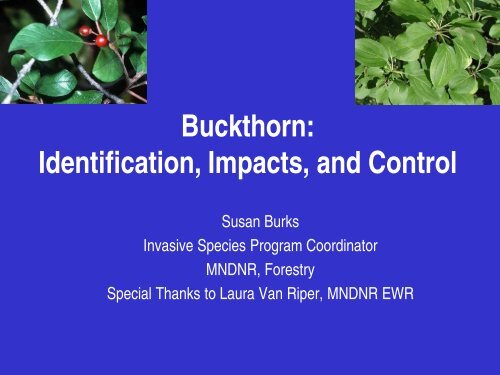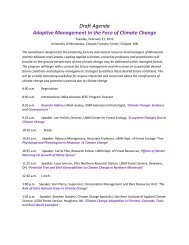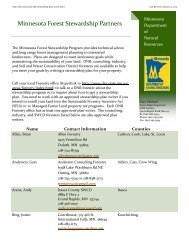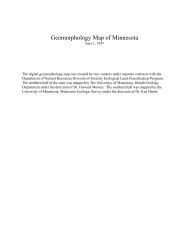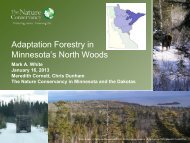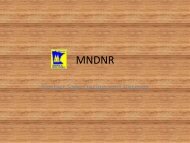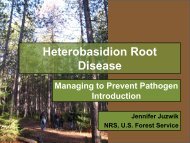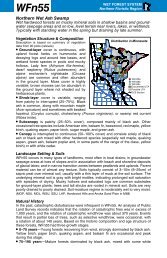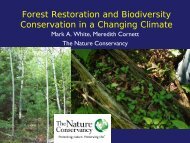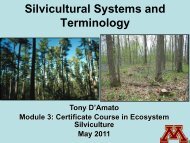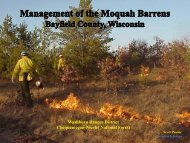Buckthorn: Identification, Impacts, and Control
Buckthorn: Identification, Impacts, and Control
Buckthorn: Identification, Impacts, and Control
- No tags were found...
Create successful ePaper yourself
Turn your PDF publications into a flip-book with our unique Google optimized e-Paper software.
<strong>Buckthorn</strong>:<strong>Identification</strong>, <strong>Impacts</strong>, <strong>and</strong> <strong>Control</strong>Susan BurksInvasive Species Program CoordinatorMNDNR, ForestrySpecial Thanks to Laura Van Riper, MNDNR EWR
Common <strong>and</strong> Glossy <strong>Buckthorn</strong>• 2 species in MN• Native to Europe• Invasive in MN• Widely planted forhedgerows, starting inmid-1800s• Both species (<strong>and</strong> theircultivars) are nowrestricted noxious weedsin MN (can’t sell ortransport)Common buckthorn(Rhamnus cathartica)Glossy buckthorn(Frangula alnus)(Heneghan et al. 2002; Schmidt <strong>and</strong> Whelan 1999)
Economic <strong>Impacts</strong>• Forms dense thickets– Shades out hardwoodregeneration– Excludes herbaceousplants– Hinders trail & woods use• Overwintering host for soybeanaphids – a pest of soybeancrops• Host for a crown rust fungusthat impacts oat crops
Ecosystem <strong>Impacts</strong>• Changes soil nitrogen, increase soil pH• Reduces leaf litter layer• Possible facilitation of earthworm invasions– All earthworms are non-native to MN• Possible effects on native plants through allelopathy orcompetition• Shades out other plants– contributes to erosion• Degrades wildlife habitat
How do I recognize buckthorn?There are native look-alikesCommon buckthornRed Twig DogwoodGrey Dogwood & <strong>Buckthorn</strong>
Common <strong>Buckthorn</strong>Common <strong>Buckthorn</strong>• Leaves alternate or subopposite,bluntly toothed• Twigs tipped with sharp thorn• Buds pressed to stem• Leaves with 3-5 curvedparallel veins• Berries black with severalseedsCherries & Plums• Leaves alternate• Buds often clustered neartips• Berries red or black withsingle hard seed• Some species have thorns<strong>Buckthorn</strong>Cherry
Glossy <strong>Buckthorn</strong>Smooth leaf edge, Alternate leaves,7-9 pair of leaf veins
Time of year• Fall: Both buckthorn species hold theirleaves later than native trees• Spring (May): flowers are small, yellowgreen,not very showyCommon buckthorn flowerGlossy buckthorn flower
Make sure its buckthorn!!There are native look-alikesGrey DogwoodCommon <strong>Buckthorn</strong>Black CherryRed Twig Dogwood
Chemical <strong>Control</strong>• The chemical <strong>and</strong> the application method used depends on the targetspecies <strong>and</strong> site conditions.• Do you homework - know which product works best in your situation<strong>and</strong> how to use it.• Always follow label directions – it’s the law• Always wear safety equipment prescribed on the label• Plan ahead for accidental spills• Track conditions at time ofapplication so can assesstreatment success (or failure)• Store product in safe (child-proof)location
Herbicides• For cut stump or frill treatments– Triclopyr (Ortho Brush-B-Gon, Garlon 3A or 4)– Glyphosate (Roundup, Rodeo, etc.)• For basal stem– Triclopyr ester, oil dilutent (Garlon 4)• Foliar applications– Glyphosate (Roundup, Rodeo, etc.)– Triclopyr amine (Garlon 3A)• Glyphosate will kill all actively growing/green tissue onwhich it is sprayed (cambium or leaves)• Triclopyr will kill broadleaf plants <strong>and</strong> will not harmgrasses when applied properly.
Roundup Brush KillerSome BrushKillers containTriclopyr (amine)Garlon 3ACrossbow-Triclopyr<strong>and</strong> 2-4, DGarlon 4 & Remedy-Triclopyr (ester)Diluent Blue-solvent
Timelines• Mark trees in fall after natives drop their leaves• Cut-stump, frill & basal bark treatments can beapplied anytime temperature >32° <strong>and</strong> snow coverisn’t too deep• Foliar applications are best in early spring beforenative plants bud out or in fall after native plantshave gone dormant• Do not treat during April, May or June
Tools• Brush cutters• Saws• Pruners• Sprayers• Dob <strong>and</strong> wickapplicators• Weed wrenches
Cut Stump Treatment• Cut plant near ground &treat cut surface with alabeled herbicide• Use dye to see whereyou’ve treated• Treat outer growth ring
Cut Stump Continued• Cut stump treatment can create large volumes of brush.• Pile on site, chip, burn, or haul brush to a brush dump.• Consider use as biofuel• Be sure to get permitMDA before transportingmaterialfrom
Hack (Frill) & Squirt Applications• Cuts are made aroundthe stem at a downwardangle through thecambium <strong>and</strong> into thesapwood.• Herbicide is applied tothe cut surface.
Low Volume Basal Bark Spray• Wet basal part of treefrom 18 inches to groundlevel• Do not wet to point ofrunoff• Tree can be left st<strong>and</strong>ing• Need an oil-basedherbicide
Foliar Application• Works well on seedlings <strong>and</strong> smallplants.• Can be used as a spot spray orbroadcast applications (monoculture)• Do not spray nativeplants. Herbicides willkill native herbaceousnatives.• <strong>Buckthorn</strong> seeds remainviable for 5 years – needto follow-up
Mechanical <strong>Control</strong>• H<strong>and</strong> pulling effective on shallowrooted seedlings• Weed wrench works well onsmall to medium saplings• Pull major roots & place wherewon’t reroot• Soil disturbance may harmnative species or createseed bed for invasive species• Tamp soil & native plants backinto place
Follow-up Mgmt• Seedlings & sprouts growquickly & can crowd outdesirable species• Follow-up control a mustOak seedling<strong>Buckthorn</strong> seedlings• Larger trees were killed, butnot under-story seedlingswhich again took over the site
Biological <strong>Control</strong>• Several potential species for common buckthorn• Testing host-specificity• Evaluating high levels of seed <strong>and</strong> seedling mortality inEurope to determine cause• Challenges– Obtaining <strong>and</strong> rearing hosts <strong>and</strong> insects under lab conditions– Limited choice of insects that are both host specific ANDcapable of causing high damage levels on buckthorn
Restoration• Past glossy buckthorn sites(typically higher site index) mayregenerate naturally if buckthorncontrolled• Common buckthorn sites willlikely need to be seeded aftercontrol, or underplanted prior toharvestSeeded w/ red fescueFollow-up spot treatments canalso help release desirable plants
Any Questions?• Susan Burks• Susan.burks@state.mn.us• 651-259-5251


